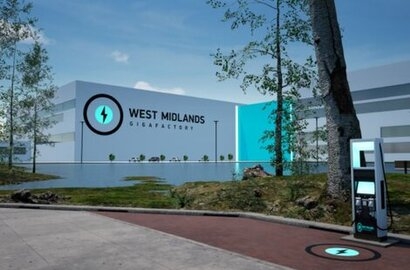
Located in the epicentre of the UK’s automotive industry, the Gigafactory will begin supplying high-tech batteries for electric vehicles from 2025. It will be the result of a £2.5 billion investment, creating up to 6,000 new highly skilled jobs directly and thousands more in the wider supply chain in Coventry and the surrounding region.
This strategically crucial investment is an imperative for the UK’s electrified future, especially for the automotive industry which will stop producing petrol and diesel engines from 2030.
The new Gigafactory, which will command over half a million square metres of space – equivalent to 74 full-size football pitches, will be one of the largest single industry facilities of any kind in the UK and at full capacity will be capable of delivering up to 60 GWh of production per year.
It will be powered by a planned major boost to the local energy network, giving the Gigafactory access to a 100 percent renewable electricity supply, from a combination of solar power and grid-supplied renewables. The West Midlands Gigafactory will be able to recycle used batteries as well as build new ones in an industry leading approach known as “cradle to cradle.”
“The West Midlands Gigafactory has a singular mission to create a state-of-the-art battery gigafactory in the heart of the UK automotive industry” said Mike Murray, West Midlands Gigafactory Project Director. “It will provide a huge cash investment in the area, leading to thousands of well-paid jobs and creating crucial new skills for this country. The Coventry Airport site is perfectly located to do just that, being ideally positioned to supply the UK’s leading automotive manufacturers who need access to world-class batteries on their doorsteps. We need to make these advanced lithium-ion batteries where we make cars and there is no better place than in the West Midlands.”
Cllr Jim O’Boyle, Cabinet Member for Jobs, Regeneration and Climate Change, added that Coventry is the historical home of the automotive industry in the UK, where much of the cutting-edge technology that defined the global car industry last century was created here in the city.
“Now, as we stand at the dawn of a new electric age, we fully intend for Coventry to be very front of the green industrial revolution which will power the future of the automotive industry” Cllr O’Boyle said. “The West Midlands Gigafactory is a unique public private sector joint venture between Coventry City Council and Coventry Airport Ltd, supported by an alliance of local governments, industrial groups and universities. It will provide a huge amount of certainty to our automotive industry, as well as providing much needed jobs and investment to our region. This project puts Coventry at the heart of the British battery industry, giving it access to the region’s world-class skills, R&D and supply chain capabilities.”
Based at Coventry Airport, the Gigafactory will be adjacent to the UK Battery Industrialisation Centre, part of the UK Government’s Faraday Battery Challenge. The Centre provides a critical link between research at laboratory or prototype stages and the successful mass production of new battery technologies. These links will be hugely important to the future development of the Gigafactory in the West Midlands.
West Midlands Gigafactory has support from a unique alliance of West Midlands industrial groups, local government and academic institutions. This alliance includes the West Midlands Combined Authority, Warwick District Council, Warwickshire County Council, Rugby Council, Warwick Manufacturing Group at University of Warwick, Coventry University and the Manufacturing Technology Centre.
Coventry Airport was first opened in 1936 by Coventry City Council which continues to own the freehold of the site. It operated as RAF Baginton during the Second World War and commercial passenger flights were subsequently reinstated until 2009. Rigby Group plc acquired the long leasehold in 2010 and it remains in its ownership.
An outline planning proposal for the West Midlands Gigafactory was submitted in July and the application is yet to be determined.
For additional information:

